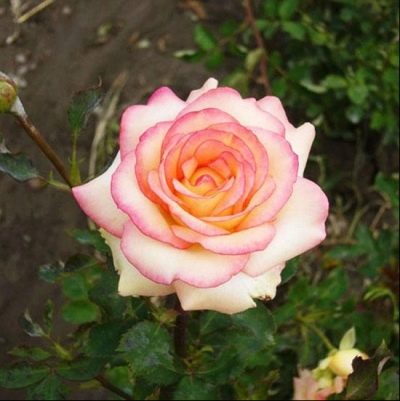
- Name synonyms: Amazon
- Group: tea-hybrid
- The main color of the flower: pink
- Flower size: large
- Diameter, cm: 10-12
- Flower type by number of petals: thick double
- Scent: mouth-watering
- Description of the bush: small, spreading
- Bush height, cm: 80-100
- Leaf size: large
The Amazon rose variety belongs to the category of hybrid tea, it is used mainly in cutting for making bouquets and floristic compositions. Its main values are the expressive color of the flower petals, the splendor of the corolla, and the long-term preservation of an attractive appearance. The variety is promising for commercial cultivation, private gardening.
Breeding history of the variety
A variety of American selection, introduced into culture in 1992. The originator is Jack E. Christensen.
Description of the variety
The Amazon rose forms small sprawling bushes 80-100 cm high. They are heavily leafy, prone to thickening. Shoots are strong, not very flexible, straight. Several flowers are formed on the stem. The leaves on the plant are large, dark green.
The Amazon rose blooms, forming large two-color corollas. The main color of the flower is pink. The buds are light orange, goblet. The blossoming flower has a diameter of 10-12 cm, a dense double structure. The color of the petals is yellow-cream, with a gradual transition to pink and red-crimson edges.
Advantages and disadvantages
The Amazon is a highly decorative rose with many virtues. Its advantages include:
- unobtrusive aroma;
- spectacular gradient color of petals;
- long-term preservation in the cut;
- resistance to rain and wind;
- compact size of the bush;
- unpretentiousness;
- long flowering.
The disadvantages include the plant's tendency to grow. Bushes have to be thinned more carefully. In severe frosts, roses of this variety can die even under cover.
Flowering features
Blooming rose. The budding period lasts from June to October. Forms flower brushes.
Use in landscape design
The main purpose of the variety is cutting. It is also used for distillation. In the garden, the Amazon rose looks great in group plantings in the foreground. Can be grown in flowerpots or as a greenhouse plant. In the group, this rose goes well with yellow and purple clematis, climbing plants.
Growing regions
The hybrid tea Amazon can be grown in the open field in the conditions of the Moscow region and the entire Central region. She doesn't like extreme heat. In southern climates, it is worth taking care of the shading of the bushes.
Landing
For the Amazon rose in the garden, it is advisable to choose sunny or semi-shaded places. For planting, plants are selected for 2-3 years with several strong shoots, a height of 30 cm. It is better to acidify the land on the site with peat beforehand. When choosing a seedling with a closed root system, the earthen lump from the container is preserved, only it is sprinkled with soil from the pit. The root collar is located below ground level.
Growing and caring
The variety is drought-resistant, able to withstand some time without abundant watering, but the lack of moisture affects the decorativeness of the plant. Top dressing of the bush is enough 2-3 per season. It is better to use organics in the spring and special liquid complexes with minerals during budding.
Frost resistance and preparation for winter
Plants need shelter for the winter.They tolerate short-term temperature drop down to -18-23 degrees, have high frost resistance. After severe cold weather, they quickly restore the ability to shoot.
Diseases and pests
The variety is practically not affected by diseases and pests. Very resistant to powdery mildew, black spot.
Reproduction
The Amazon rose is propagated mainly by cuttings. It is also possible to root cuttings from young shoots 1 year old.
Review overview
On Russian garden plots, the Amazon rose is not a very frequent visitor. But those summer residents who chose her for planting note the extraordinary beauty of her flowers. It is indicated that in shaded gardens, the color of the petals is obtained with a transition from salmon to coral. With an excess of the sun, they brighten, fade to yellow-orange. Other advantages of this variety, gardeners include the constant formation of buds, good protection of the rose from major diseases.
The disadvantages of summer residents include difficulties with the acquisition of planting material. In addition, self-rooting of cuttings is also often unsuccessful. Watering or fertilizing too much can cause plants to rot in the root area.































































